
Global Microlearning Platforms Market Competitors, Segment Types and Downstream Applications Research Report 2025



Research Summary
Microlearning platforms are digital tools or platforms designed to deliver learning content in small, bite-sized modules or units. These platforms leverage technology to provide learners with access to concise and focused learning materials that can be consumed in short periods, often ranging from a few minutes to around ten minutes. They often utilize multimedia elements, such as videos, quizzes, interactive activities, and infographics, to deliver engaging and interactive learning experiences. Microlearning platforms are typically designed to be easily accessible and user-friendly, often accessible through web browsers or mobile applications. They offer flexibility in terms of when and where learners can access the content, allowing for self-paced learning and personalized learning paths. These platforms are widely used in corporate training, e-learning, and continuous professional development, as they enable learners to acquire knowledge and skills in a time-efficient and targeted manner, filling gaps in knowledge or providing quick refreshers on specific topics.
According to WENKH research statistics, the global Microlearning Platforms market size will reach 2,196.63 Million USD in 2025 and is projected to reach 5,104.12 Million USD by 2032, with a CAGR of 12.80% (2025-2032). Among them, the Asia-Pacific Microlearning Platforms market is undergoing rapid changes, reaching Million USD in 2025, accounting for approximately % of the global market share. It is projected to reach Million USD by 2032.
The global Microlearning Platforms market is highly competitive, with key market players including Saba Software, Mindtree, Bigtincan, BrainStorm, Axonify, Ispring, Sponge, SwissVBS, Epignosis, Gameffective (Centrical), Whatfix, Qstream, Allen Interactions, Grovo, Trivantis, Fivel, EdApp, EduMe, Float, Gnowbe, Verb, HandyTrain, MLevel, ExpandShare, etc. This report categorizes the competitive landscape of the global Microlearning Platforms market into three tiers based on annual revenue, with the top three market players holding approximately % of the total market share.
This report provides an in-depth analysis of the global Microlearning Platforms market, including market size, price trends, market status and future development prospects. It particularly focuses on the market share, product characteristics, pricing, sales revenue, and gross profit margin of major players in the global Microlearning Platforms industry. Additionally, this report provides an in-depth analysis of the market status and future development trends of different product segments of Microlearning Platforms and their downstream application fields.
In terms of data, this report includes a comprehensive time-series dataset. The historical data spans from 2020 to 2024, providing a solid foundation for analyzing past market trends. The year 2025 is used as a base year to accurately assess the current market landscape. Forecast data covers the period from 2026 to 2032, utilizing scientific analysis methods and models to offer forward-looking predictions and insights into the market's future development. This provides valuable reference information for industry participants and stakeholders.
The report covers countries including United States, China, Germany, Japan, France, South Korea, United Kingdom, India, Italy, Brazil, Mexico, Indonesia, Vietnam and South Africa. It particularly focuses on the sales revenue of Microlearning Platforms in these countries, as well as the product segmentation and downstream application market size of each country. The report provides an in-depth analysis of the regional distribution and future development trends of the Microlearning Platforms market. By considering local policies, this report evaluates the market prospects of Microlearning Platforms in each country, aiming to help companies gain a comprehensive understanding of the industry characteristics and development potential in different regions, optimize regional business layout, and develop precise market strategies to achieve global development goals.
This report places a strong emphasis on data quality and reliability, utilizing diverse and extensive data sources to ensure the accuracy and validity of the information presented. Primary data collection involves multiple channels, including in-depth interviews with senior executives, industry experts, supply chain stakeholders, and end consumers. These interviews provide key insights into corporate strategic planning, industry policy interpretation, supply chain dynamics, and end-user experiences. Secondary data sources cover a wide range of authoritative statistics from government agencies, customs databases, industry associations, third-party paid databases, brokerage research reports, academic research findings, corporate annual reports, financial statements, real-time news updates, and relevant information from international organizations. These data sources serve as a solid foundation for verification and analysis.
Companies Covered
Saba Software
Mindtree
Bigtincan
BrainStorm
Axonify
Ispring
Sponge
SwissVBS
Epignosis
Gameffective (Centrical)
Whatfix
Qstream
Allen Interactions
Grovo
Trivantis
Fivel
EdApp
EduMe
Float
Gnowbe
Verb
HandyTrain
MLevel
ExpandShare
Product Segment
Cloud Based
Web Based
Product Application
Retail
Manufacturing & Logistics
Finance & Insurance
Automotive Retail
Others
Chapter Scope
Chapter 1: Product Statistical Scope, Product Segmentation Types and Downstream Applications, Overall Market Size, Current Status and Development Prospects
Chapter 2: Global Microlearning Platforms Industry Chain Analysis
Chapter 3: Global Microlearning Platforms Industry Environment Analysis and Porter's Five Forces Analysis
Chapter 4: Analysis of the Competitive Landscape of Major Companies in the Global Microlearning Platforms Market (Market Share, Product Revenue Comparison, Tier Division, Corporate Expansion and M&A Trends)
Chapter 5: Analysis of Global Major Companies (Company Profiles, Product Specifications and Features, Product Revenue and Product Gross Profit Margin)
Chapter 6: Global Microlearning Platforms Market Analysis by Countries, Product Segment and Downstream Application
Chapter 7: United States Microlearning Platforms Market Size, Product Segment, Downstream Application Analysis
Chapter 8: China Microlearning Platforms Market Size, Product Segment, Downstream Application Analysis
Chapter 9: Germany Microlearning Platforms Market Size, Product Segment, Downstream Application Analysis
Chapter 10: Japan Microlearning Platforms Market Size, Product Segment, Downstream Application Analysis
Chapter 11: France Microlearning Platforms Market Size, Product Segment, Downstream Application Analysis
Chapter 12: South Korea Microlearning Platforms Market Size, Product Segment, Downstream Application Analysis
Chapter 13: United Kingdom Microlearning Platforms Market Size, Product Segment, Downstream Application Analysis
Chapter 14: India Microlearning Platforms Market Size, Product Segment, Downstream Application Analysis
Chapter 15: Italy Microlearning Platforms Market Size, Product Segment, Downstream Application Analysis
Chapter 16: Brazil Microlearning Platforms Market Size, Product Segment, Downstream Application Analysis
Chapter 17: Mexico Microlearning Platforms Market Size, Product Segment, Downstream Application Analysis
Chapter 18: Indonesia Microlearning Platforms Market Size, Product Segment, Downstream Application Analysis
Chapter 19: Vietnam Microlearning Platforms Market Size, Product Segment, Downstream Application Analysis
Chapter 20: South Africa Microlearning Platforms Market Size, Product Segment, Downstream Application Analysis
Chapter 21: Research Conclusion
Chapter 22: Methodology and Data Source
Purpose and Value of the Report
Market Trend Insights: Analyze industry trends, market dynamics, and future growth potential to help companies forecast changes and develop strategic plans.
Competitive Landscape Analysis: Understand key players' revenue segmentation, strategies, market share, and business models to guide competitive decisions.
Investment Decision Support: Provide feasibility analysis through market size, growth rate, demand trends, and potential risks for informed investment decisions.
Target Customer and Demand Analysis: Examine consumer behavior, purchasing preferences, and pain points to optimize products and improve market penetration.
Policy and Regulatory Insights: Interpret relevant industry policies to ensure compliance and mitigate regulatory risks.
Business Model Optimization: Offer data-driven suggestions for enhancing business models and improving profitability.





